October 31, 2023
How to Record Online Course Videos

Dominic
Recording your first online course video can be a daunting task.
If you’ve never used video or never created educational materials before, starting from scratch can feel like getting dressed in the dark.
How do I know this?
Because I was in the same position about 18 months ago.
Fast forward those 18 months and I’ve made thousands in online course sales, have many videos on YouTube, and use videos with almost all my customers.
In this post, I’m going to share how I recorded my first online course video and throw in some bonus tips for creation and promotion 👇.
Prepping your online course
Recording your online course videos
Editing before shipping the final product
How to sell video courses online
1 - Prepping your online course
There are three key areas to consider when preparing your online course:
What are you going to record?
Are you going to make money from your online course?
How are you going to record your online course video?
What are you going to record?
For the “what”, think about your core online course content.
You might be creating an online course video to help other copywriters conquer writer’s block.
It might be a video course on how to gain more social media followers.
Or it could be something super-specific to your set of niche skills, like knitting or football analysis.
When you know your topic, it’s time to think about the format.
Formats include:
Live demos
End-to-end walkthroughs
Q&As
Simply talking to the camera
A mixture of all the above
Judging what your audience wants rather than what you’d like to do is key here. If you don’t think about your audience, they will lose focus and you stand less of a chance of them referring to their peers.
So now you know what your course is going to be about and how you’re going to structure it.
Before you dive in and start recording, what is your goal for this course?
If it’s to grow your personal brand or grow a community, it needs to be high-quality.
But if people are parting with their money at any point, it needs to be high-quality.
If you don’t want to charge for your online course video, there are still other ways to make money.
How do you monetise a video course?
In the preparation phase, think about whether and how you’re going to make money from your video course.
Even if you don’t plan to charge a fee, stick around in this section as you could be leaving money on the table.
Here are 10 ways to monetise a video course:
Charge a one-off fee
Charge a recurring fee
Find a sponsor
Use affiliate links
Create your own affiliate program
Monetise your YouTube channel
Promote your other products
Promote your other services
Embed your course to your blog and turn on AdSense
Add a tipping service like Buy Me A Coffee
If you intend on charging for your course, platforms like Gumroad and Udemy offer easy upload processes.

Spend some time getting to know each platform. They have different payout methods and different in-platform sharing options.
How are you going to record your online course video?
For the “how”, the first thing to need to assess is your equipment setup.
The basics you’ll need include: a webcam or DSLR camera, a microphone, and lighting. Let’s assume you’ve already got a laptop or PC at this point.
You could spend ages researching which webcams YouTubers use or you could opt for something that will get the job done.
Unless you’re aiming for seriously high production, the Logitech Brio paired with an Elgato Key Light Air is a solid combination for recording online course videos.
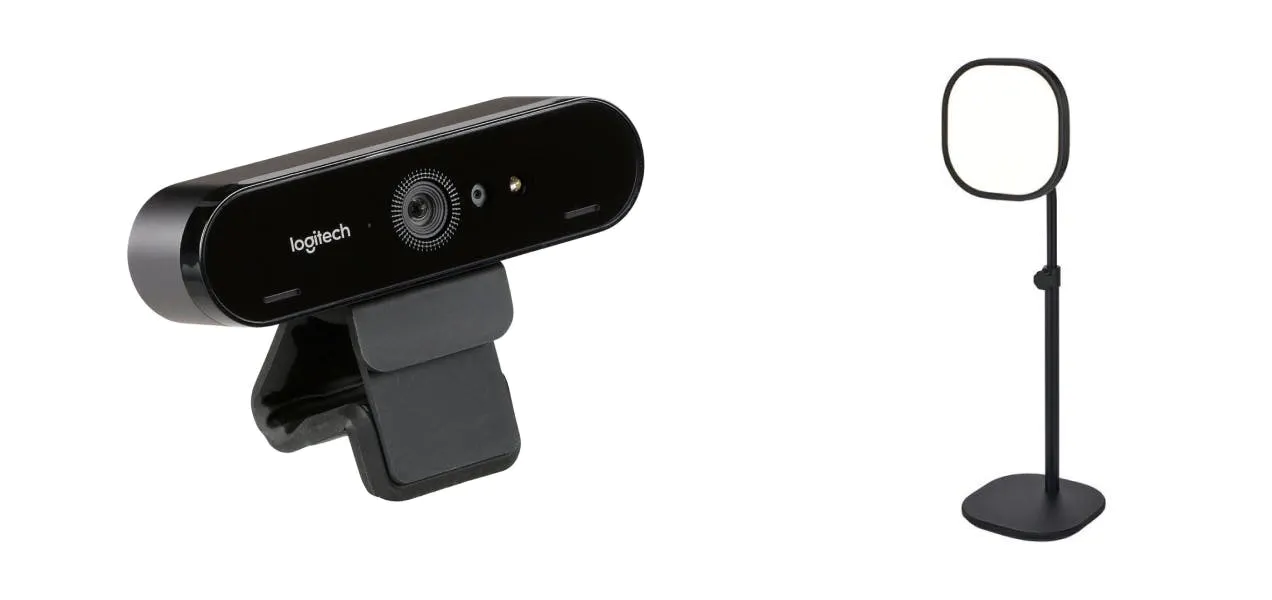
The most important element when creating an online course video is your audio.
Viewers are forgiving of less-than-perfect camera quality and lighting if they can hear you.
Having been through many microphones, I’ve landed on the Shure MV7. It’s far superior to anything else in its price bracket.
The final piece of equipment you may need is a laptop stand. When recording your online course videos, think about the camera position and what you want the viewer to see.
In the image below, you can see I recycled my unused jewellery box instead. I pop my laptop on top when I need to record.
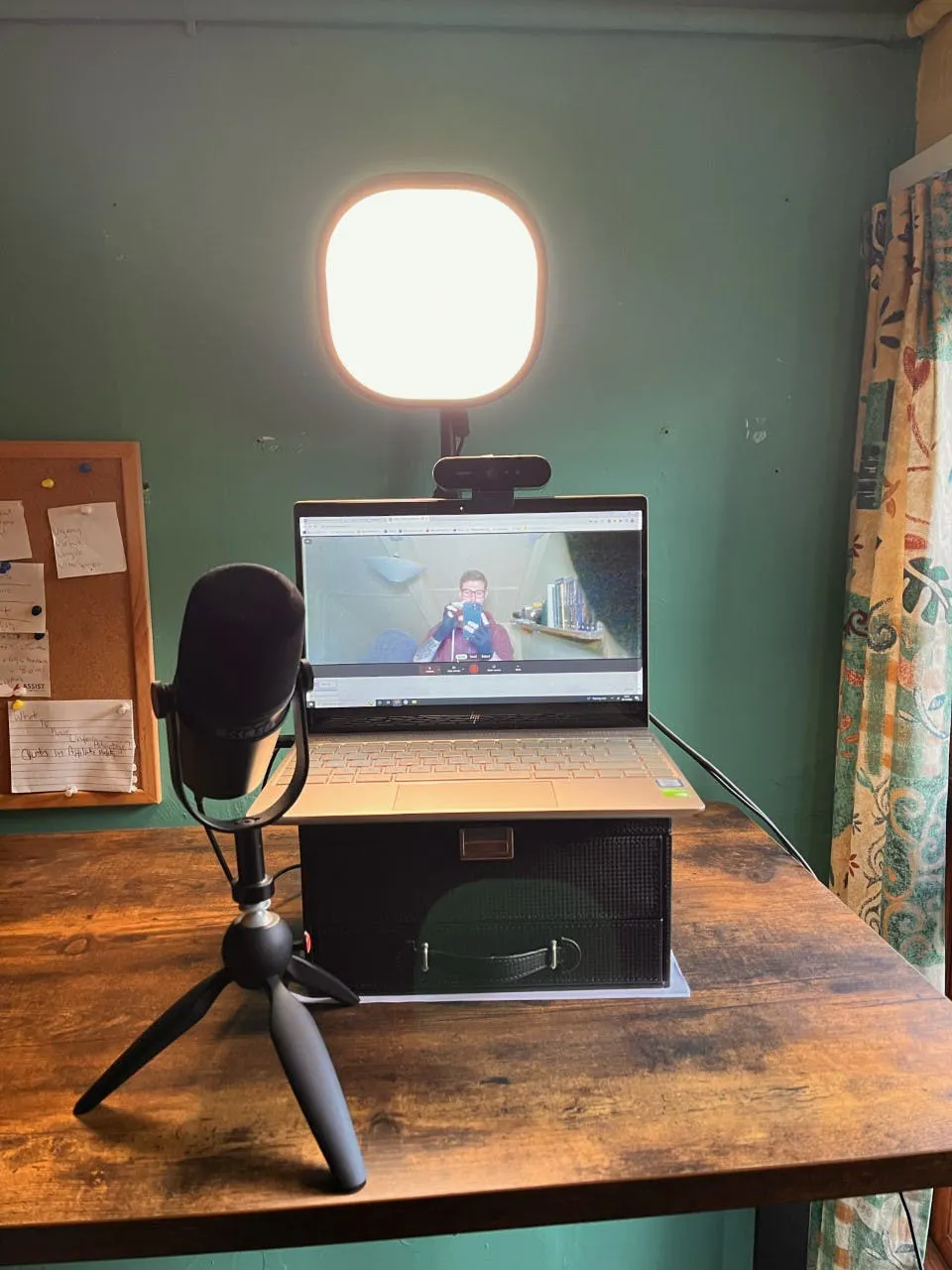
While this setup doesn’t look particularly Hollywood, it falls within budget and ticks all the boxes for great quality online course videos.
2 - Recording your online course videos
Now it’s time to get recording.
The missing piece of the puzzle is your video recorder.
Head to tella.tv and start recording videos straight from your browser.
With Tella, you can record your screen and webcam simultaneously so you don’t need to stitch elements together after recording.
It’s also free for your first 10 videos and there’s no limit on screen recording time.
When you sign up to Tella (in just four clicks), you can start recording straight away. There’s nothing to install and nothing to configure.
If you’re ready to record straight away, hit New video in the top left-hand corner, and your recording screen launches.

Here, you have options to mute/change your microphone, turn on/off your camera, and share your entire screen, tab, or slides.
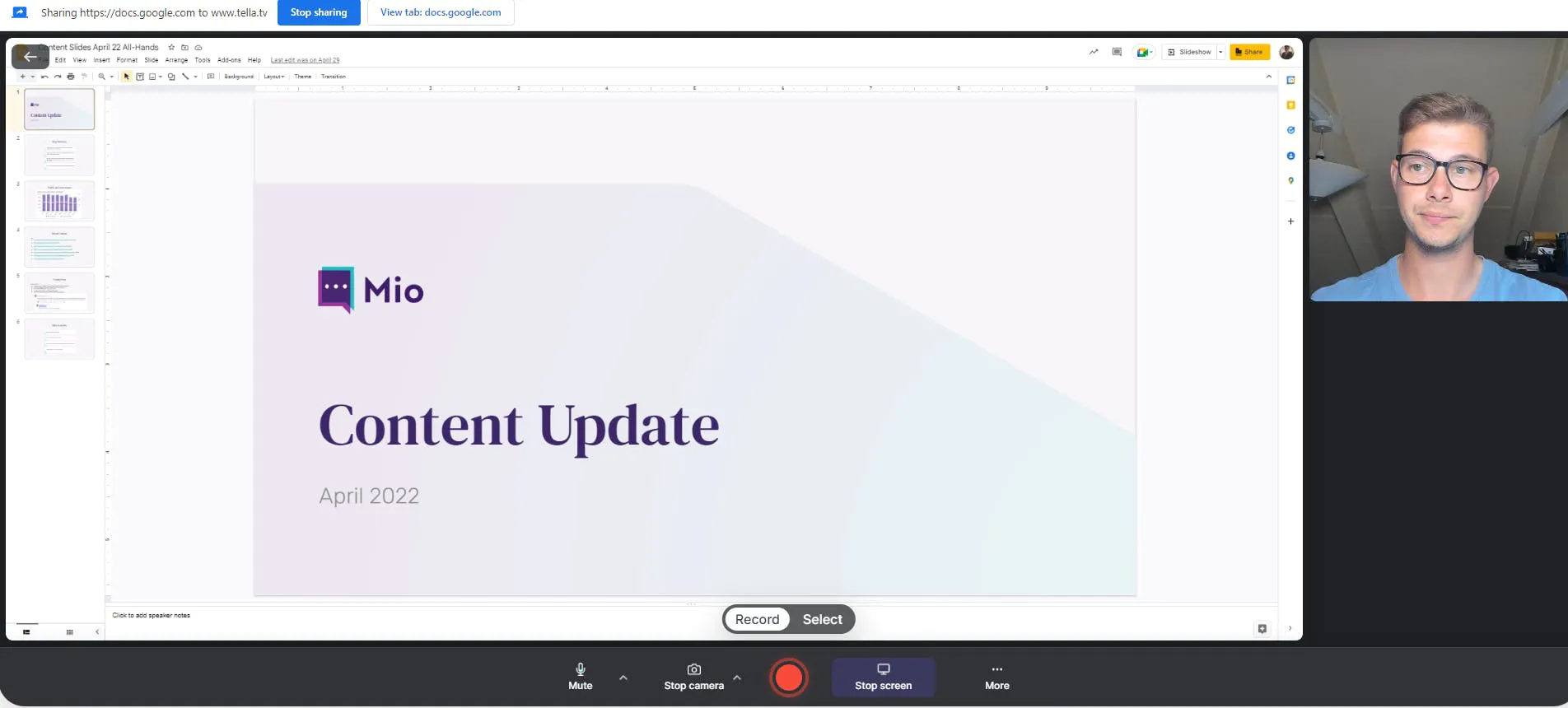
When you’ve tailored your setup, hit the red record button in the centre of the bottom menu.
Once you’ve started recording, you can either record your entire course in one go or choose to record clip by clip.
If you choose the latter, you can merge multiple clips to become one video when you’re done recording.
3 - Editing before shipping the final product
In the unlikely event that you’ve nailed your course video first time, go celebrate!
If not, Tella automatically moves you to the edit screen. On the right-hand side, you’ll see all your editing options.
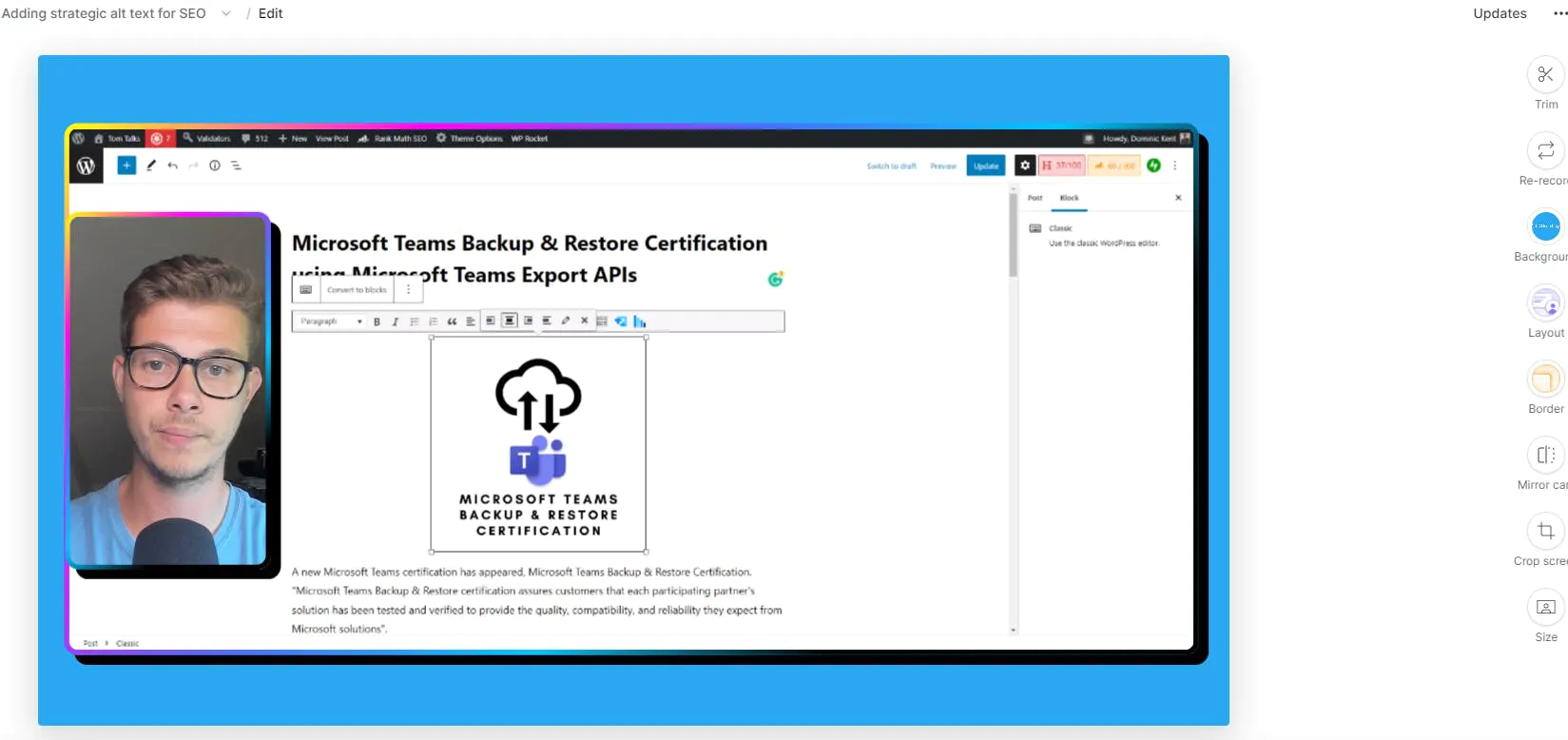
Without any video editing skills, you can make the following changes:
Add a background (see the blue background on the below screenshot)
Change orientation (landscape, portrait, square)
Trim your video of unnecessary content
Re-record parts of your video
Mirror your camera
Add a border
See the blue background on my video? That could be a preset background or your own custom one.
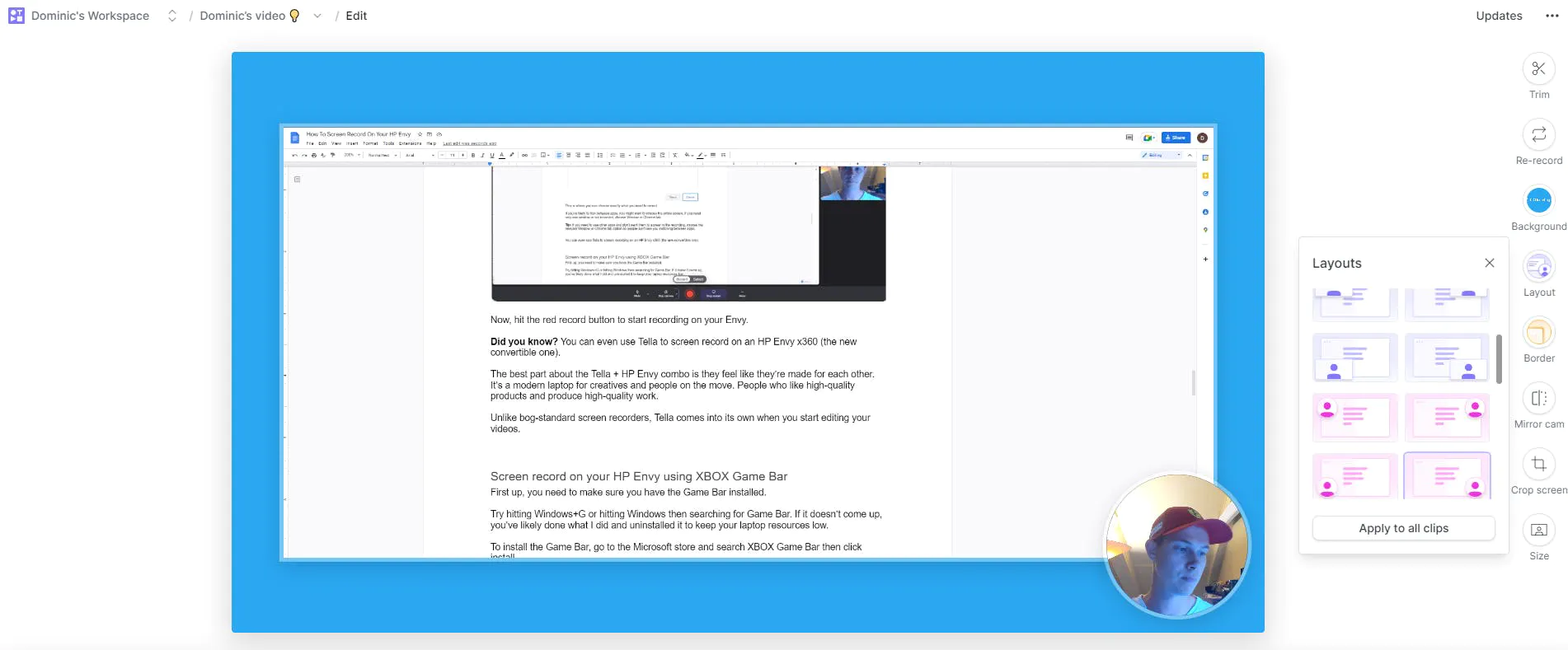
Notice my head is in the bottom right-hand corner. By choosing a different layout, I can move my head to anywhere else in the video with one click.
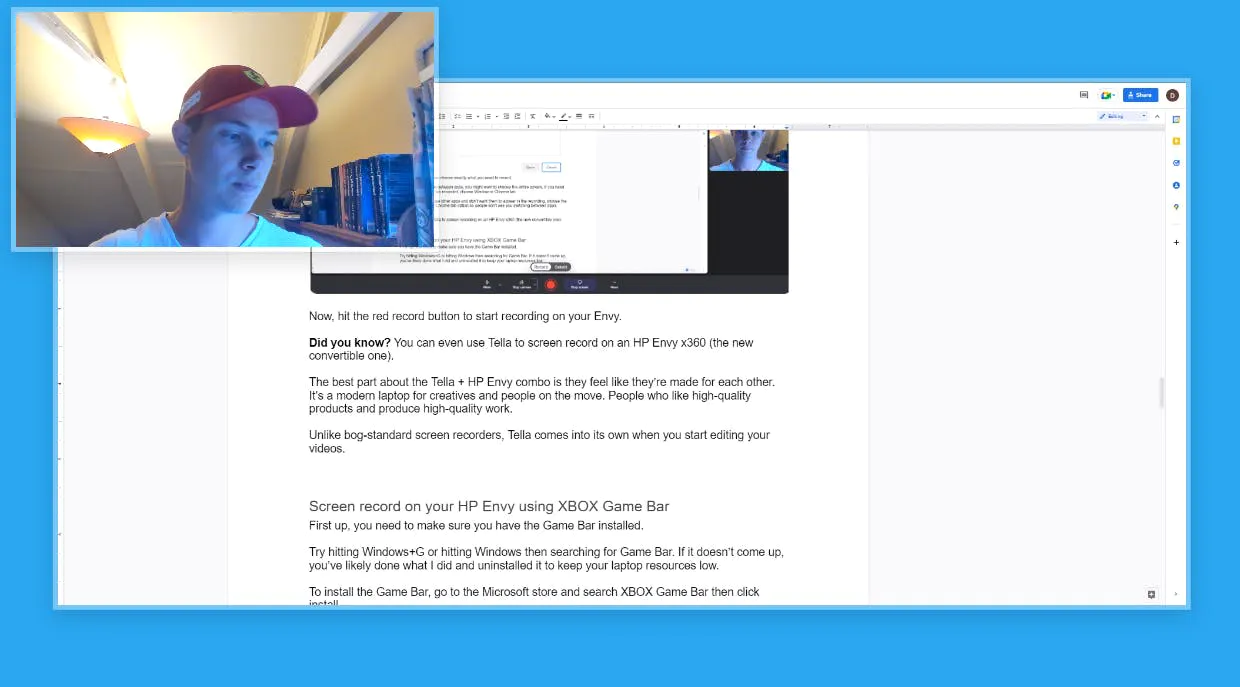
I also changed from a circle to a square because I thought it looked neater.
None of these editing options need any coding experience or third-party apps. Just a few clicks of your mouse, touchpad, or touchscreen.
Once you’ve finished editing, you get the option to download or share your video.
Congratulations! You’ve just recorded your first online course video.
When you’re happy with your final product, you might think that it’s the end of the process.
It’s only the end if you don’t want anybody to watch it.
Next, let’s dig into 10 platforms to share your online course and learn how to hyper utilise them.
4 - How to sell video courses online
What we’re not going to do here is simply share your course on social media.
Sure, social media plays a big part in video distribution. But we’re going to focus on finding the right places to promote your online course. And once we’ve found them, we’re going the extra mile to use all the free functionality available.
How do I sell a course on the internet?
Selling online products means you need to get in front of the right people online.
Let’s walk through which platforms to use and how best to use them.
1 - Twitter
We all know how to send a tweet. But few people spend enough time planning their tweets.
Things to consider when promoting your online course on Twitter include:
Timing: when is your audience engaged?
Imagery: what does your audience respond to?
Pricing: what’s affordable for your followers?
Take a look at the anatomy of a great social media post before you start sharing your course.
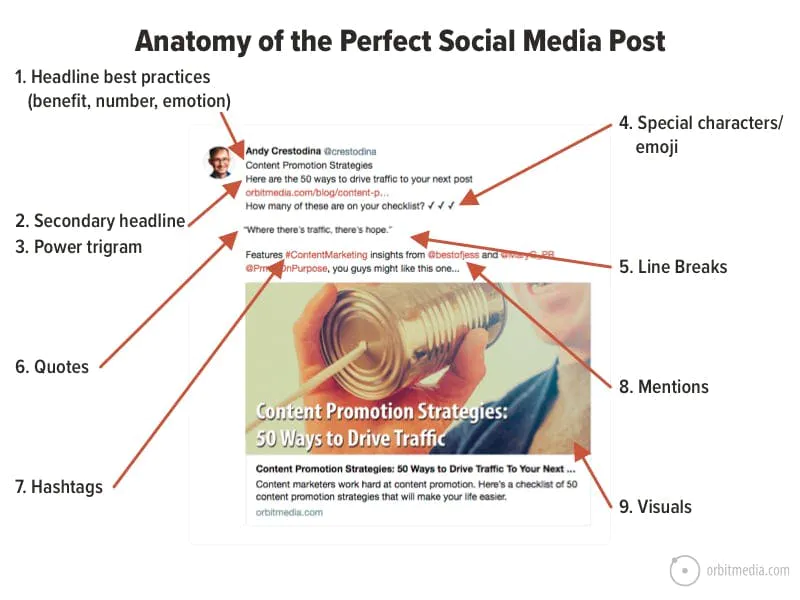
Outside of the promotional tweets, consider the build up to launching your course.
If you talk about a product and get people’s opinions while you’re making it, you stand a better chance of turning those people into buyers.
In contrast, a tweet out of the blue asking for payment rarely works.
On Twitter, you’re not limited to single tweets either.
You can craft viral Twitter threads and include a link to your online course. Of course, these take time to get right. But, like most things with marketing, the time you put is often retrieved in your sales figures.
Don’t limit yourself to your own tweets, either. When other people tweet about the topic you’ve created your online course video on, engage with them.
Not every reply needs to be “Hey, buy my course!” but making people aware you’re a subject matter expert means they might follow you then see you have a course later on.
2 - LinkedIn
A lot of the same tactics you use on Twitter apply on LinkedIn too.
Understanding when your audience is online and what they respond to are musts.
Also like Twitter, there are other ways to gain more eyeballs on your online course.
Finding LinkedIn Groups associated with your course content opens the door to an engaged pool of LinkedIn users looking for content and help on your topic of expertise.
Again, a blatant sales post may not gain many sales. Engaging and demonstrating your authority will.
To find LinkedIn Groups relevant to your course content, search your topic and filter to “Groups”.
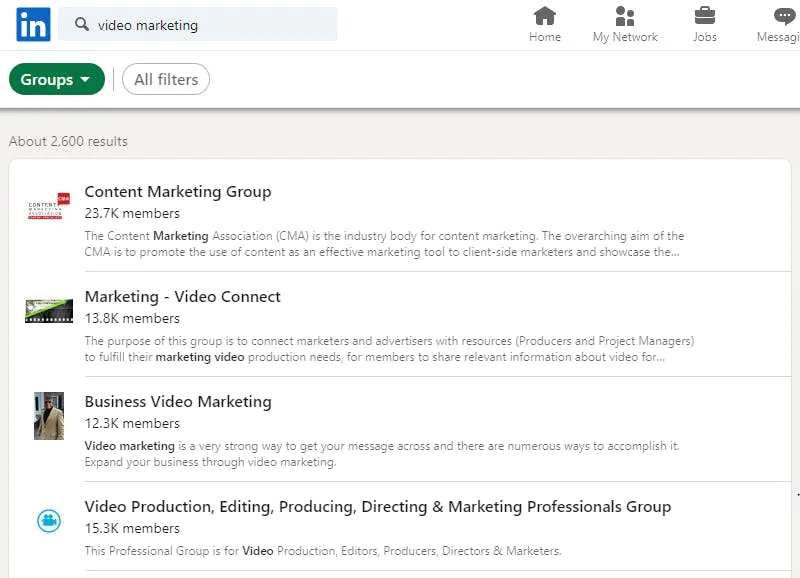
3 - Facebook
On Facebook, you’ve likely got connections who know you. They might be old school friends, family members, or people you’ve met online.
The simple act of knowing you means they might like to support you if they are also interested in your video course content.
Rather than just gambling on people being nice, Facebook is another open door to groups with engaged users,
Like LinkedIn Groups, Facebook has functionality where like-minded people can hang out and discuss niche topics.
To infiltrate these communities, you must gain trust rather than arrive and start spamming everyone.
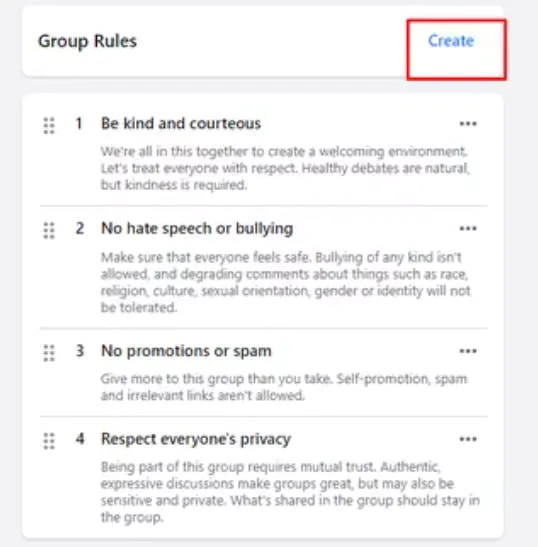
Above is a common example of “no promotions” in Facebook groups. This might be a turn-off for people who plan to dump their links and run. But gaining trust and online connections is a winning strategy.
4 - Blogs
When you write high-quality blogs that rank high on Google, you stand a great chance of being found by people with specific search intent.
This means when people search for something and you answer their questions, they are likely to invest in your product to become an expert too.
This is the tactic employed by content marketing teams in both B2B and B2C. By giving away something for free (your blog content), you are more likely to receive an exchange for a paid product.
But only if your content is high-quality.
When you’ve built trust in your blog post, find the right time to add a call to action.
It might be right at the end of your post. But it might also be more relevant at certain action points.
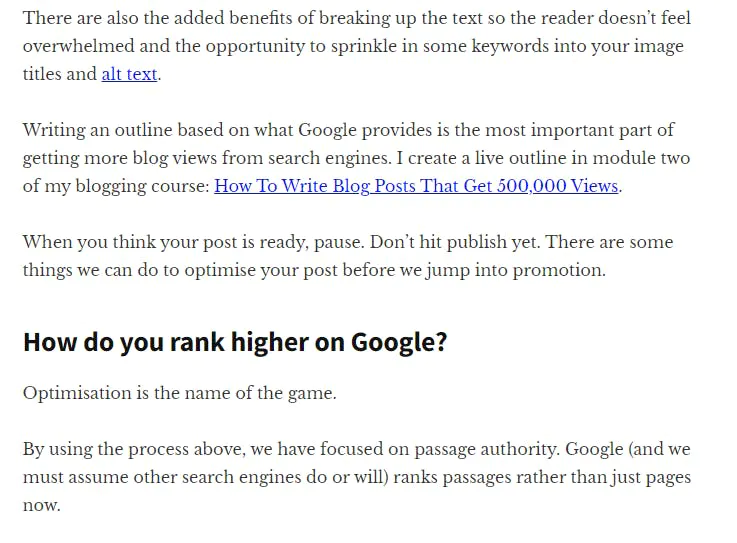
5 - Gumroad Discover
When people have started to download your online products, the platform you host them on could recognise it’s selling well.
In this case, platforms (like Gumroad) want to showcase its best creators so both parties make money.
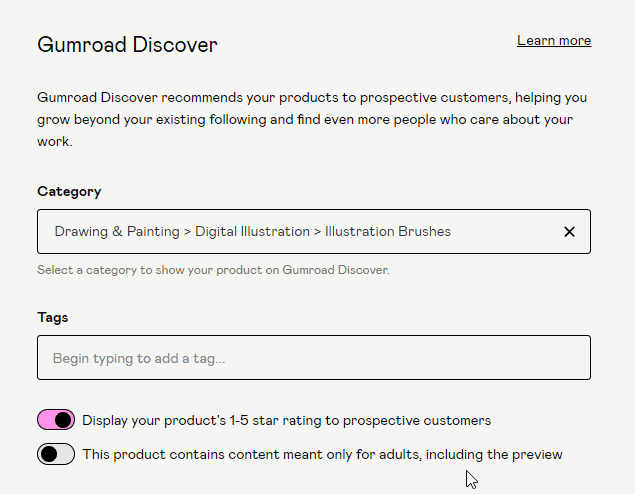
There’s no shortcut to being featured by these platforms. But you can optmise your online course using tags, categories, and displaying ratings from existing customers.
6 - Affiliates
On most online course platforms, you can create affiliate links for bloggers, influencers, and happy customers to use.
Here, they get a % (that you choose) when they refer someone with their unique link.
Pro tip: offer a higher % commission on the first five sales to encourage new affiliates to push your online course.
7 - Community
In Slack communities or any online area with an engaged audience, you’ve got an audience with a common interest.
You can penetrate these communities by becoming a regular contributor or a sponsor.
Regular helpful contributions build trust and open the door to letting someone know you have a course on that exact topic.
Becoming a sponsor shortcuts that but has the negatives of 1) costing money and 2) being a cold introduction without building trust.
8 - Podcasts
In the same way you can sponsor a community, you can also sponsor a podcast.
The key here is finding the right podcast. Advertising on any old podcast might get tons of listeners but the chance of them needing your online course doesn’t correlate.
Identify podcasts with similar interests to your course and create customised promo codes so the podcasts gets something out of it too.
Some may charge a fee or some prefer an affiliate relationship.
9 - Influencers
Like communities and podcasts, using “influencers” is tapping into existing audiences.
People with large numbers of followers or highly-engaged niche viewers take a small cut of the money you make (affiliate) or may ask for a fee in exchange for promoting.
To find the right influencers to collaborate with, check engagement stats like likes, comments, and shares as well as the number of followers.
Thousands of followers are worthless if none are engaged.
Send a DM or email to influencers you identify explaining why you think your online course is relevant to their audience. Don’t forget to include what’s in it for them 😉
10 - Email
Rather than trying to creep into other people’s audiences, why not use your own audience?
If you run an email newsletter or have email addresses from selling other products, send a one-time, time-based email offering a small discount for early buyers of your online course video.
When launching my second independent product, the majority of people who bought my first online course video made another purchase.
Offering a loyalty discount is a surefire way to lure people in if they enjoyed your first product.
Oh, and since 2023, there are a ton of subscription platforms out there now that offer so many package options for your audience. Check out our comprehensive guide on the top creator subscription platforms to see if any suit your needs.
So there we have it! You’ve successfully learned how to plan, record, monetise, and promote your online course.
What’s stopping you getting started right away?



